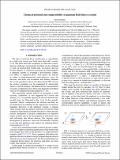Chemical potential and compressibility of quantum Hall bilayer excitons
Author(s)
Skinner, Brian J
DownloadPhysRevB.93.085436.pdf (416.6Kb)
PUBLISHER_POLICY
Publisher Policy
Article is made available in accordance with the publisher's policy and may be subject to US copyright law. Please refer to the publisher's site for terms of use.
Terms of use
Metadata
Show full item recordAbstract
This paper considers a system of two parallel quantum Hall layers with total filling factor 0 or 1. When the distance between the layers is small enough, electrons and holes in opposite layers form interlayer excitons, which have a finite effective mass and interact via a dipole-dipole potential. I present results for the chemical potential μ of the resulting bosonic system as a function of the exciton concentration n and the interlayer separation d. Both μ and the interlayer capacitance have an unusual nonmonotonic dependence on d, owing to the interplay between an increasing dipole moment and an increasing effective mass with increasing d. A phase transition between superfluid and Wigner crystal phases is shown to occur at d ∝ n[superscript −1/10]. Results are derived first via simple intuitive arguments, and then verified with more careful analytic derivations and numeric calculations.
Date issued
2016-02Department
Massachusetts Institute of Technology. Research Laboratory of ElectronicsJournal
Physical Review B
Publisher
American Physical Society
Citation
Skinner, Brian. “Chemical Potential and Compressibility of Quantum Hall Bilayer Excitons.” Physical Review B 93, no. 8 (February 25, 2016). © 2016 American Physical Society
Version: Final published version
ISSN
2469-9950
2469-9969